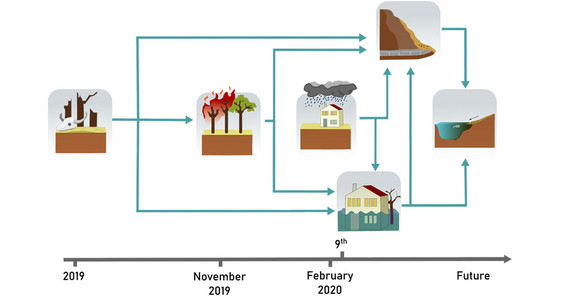Between June 2019 and February 2020 exceptional wildfires swept across Australia, killing at least 33 people, destroying ecosystems and burning an area the size of the United Kingdom. This disaster was caused by an unprecedented drought in the previous years. But these events where just the first two links in an entire chain of hazards. The fires were extinguished by heavy rainfall leading to floods and rapidly eroding the soil that was exposed by the fires. Soil, ash, and charred vegetation were flushed into the rivers and lakes, where they drastically reduced water quality.
Members of the DFG funded research training group “NatRiskChange”, together with colleagues from the DFG funded research training group “Strategy” and the Potsdam Institute for Climate Impact Research, formed a taskforce to study this hazard cascade. The concept of the taskforce is a key part of “NatRiskChange” that is meant to bring PhD students with different backgrounds and skills together, to study a recent natural disaster and to learn from each other. In the article the taskforce follows the cascade through the Manning river catchment in New South Wales, to understand the complex interactions of natural hazards. For this purpose, the scientists use publicly available satellite images, weather and river data. Their work shows that even minor hazards can have an increased impact within a cascade, which is still an underestimated challenge, especially in light of ongoing climate change. To be better prepared for future hazard cascades, the complex interactions involved in natural disasters need to be further investigated, and the events need to be included in risk analysis and planning.
The doctoral program “NatRiskChange” started in October 2015 and was extended by DFG in 2019. It will be financed until September 2024 and is dedicated to the topic “Natural Hazards and Risks in a Changing World”. The key scientific aims are the development, testing and pilot application of methods that identify, simulate, and predict natural hazards and associated risks.
Publication: Kemter et al. 2021, Cascading hazards in the aftermath of Australia’s 2019/2020 Black Summer wildfires, Earth’s Future, https://agupubs.onlinelibrary.wiley.com/doi/10.1029/2020EF001884
Contact:
Matthias Kemter, Institute of Environmental Science and Geography, DFG RTG NatRiskChange, Tel.: +49 331 977-2502, matthias.kemteruuni-potsdampde
Dr. Theresia Petrow, Institute of Environmental Science and Geography, DFG RTG NatRiskChange, Tel.: +49 331 977-5434, natriskuuni-potsdampde
Media information 15-03-2021 / No. 018


